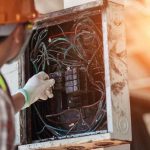There are over 20,000 fires in UK homes and businesses every year caused by electrical equipment and faulty electrics. Electrical fires are responsible for the deaths of thousands of people.
From faulty outlets and appliances to serious industrial incidents like arc flash, the main cause of electrical fires is a misuse of equipment.
Processes like Lock Out, Tag Out (LOTO or LOTOTO) to isolate electrical equipment are playing an important role in safeguarding people in industry working on electrical equipment.
So what causes electrical fires, how should they be managed and how can you actively prevent the risk of an electrical fire occurring? We’ll look at these questions in this article, as well as address a new electrical fire risk which has already been the cause of a number of serious fires in the UK – electric vehicles and their lithium-ion batteries.
For expert advice on how to avoid the danger of fire, consult the Health and Safety Authority.
What is an Electrical Fire?
The term ‘electrical fire’ is applied to any fire caused by an electrical issue, be that wiring, an appliance fire, a cable, electrical circuitry or other electrical components.
What Causes Electrical Fires?
There are many causes of electrical fires, both in the home and in the workplace. Some of the most common are listed below.
- Outdated or faulty appliances and outlets, as well as their associated cords, switches and housings
- Light fixtures where the bulb wattage is too high for the light
- Using extension cords to run electricity to appliances rather than plugging directly into the outlet
- Portable space heaters and heating units placed in close proximity to combustible materials
- Faulty wiring, particularly in older buildings where the wiring capacity may be insufficient for today’s increased loadings
Steps To Put Out an Electrical Fire
It’s important to know how to put out an electrical fire safely when a fire occurs, whether it’s in the home or in the workplace. Here are a few general guidelines on how to manage an electrical fire.
Shut off the electricity if safe to do so
If it’s safe to do so, the first step is to turn off the electricity, either to the appliance in question or to the entire property. In a commercial environment, there should be a procedure in place for specific personnel to action, and these people should receive appropriate fire safety training.
Smother the fire
If you can’t turn off the power, and if it's a small fire, then consider using a fire blanket or even a stout piece of clothing to smother the fire. Always remember that a false move could fan the flames and cause more issues with fire spreading.
Use a Class C fire extinguisher
An electrical fire is a Class C fire, so only Class C fire extinguishers should be used to put out the fire. Always read the instructions on the extinguisher first. All fire extinguishers should be inspected and maintained regularly.
If you are unable to extinguish the electrical fire
Don’t take any risks, call for emergency support immediately. If it’s safe to do so, turn off the power and evacuate the area.
In the workplace, if you’re the responsible person, check out what you should be doing. Here's further advice on preventing domestic fires.
What not to do
Not all fires are the same. What should you never use to extinguish an electrical fire?
Never Use Water
Never add water into the mix, although this may be your first instinct! Water conducts electricity. If you direct water at an electrical fire whilst the power is still connected, it can carry an electrical charge back, causing an electrocution hazard.
What fire extinguisher do you need for an electrical fire?
If you can't use water, what type of fire extinguisher can you use? Remember that many types of fire extinguishers are water-based, and therefore represent the same level of danger as water itself in an electrical fire.
Don’t use a foam-based fire extinguisher or a wet chemical fire extinguisher on electrical fires, as both are water-based solutions. Where a fire is still ‘energised’ (ie connected to a power source) the only safe option is a Class C-rated extinguisher, which means the agent will not conduct electricity.
Understanding the fire triangle
The Fire Triangle (or Combustion Triangle) illustrates that three elements must be present to create the chemical reaction to ignite and fuel a fire.
These are:
Fuel – any combustible material which will enable to fire to burn
Heat – to ignite the fire and keep it burning. Heat is produced naturally as combustible materials burn.
Oxygen – a fire requires just 16% oxygen source to burn
Fires can be extinguished by removing any one of the three Fire Triangle elements
How to Prevent an Electrical Fire From Happening in the First Place
Fires aren’t only about damage to property. Far more importantly, they endanger lives. How can you tell if you may be at risk? How do you prevent electrical fires? There are a few early warning signs of electrical issues that could lead to an electrical fire.
- Do any of your electrical appliances feel warm to the touch (in use or out of use)
- Can you smell burning when you’re using an appliance, or do you feel an electric shock when you plug it in?
- Is there any discolouration around sockets, switches or light fittings?
- Do your experience flickering lights
- Do you frequently experience blown fuses or tripped circuit breakers?
Stop using the appliance and call in a qualified electrician to check your system. In addition, there are some simple things you can do at home and in the workplace, to prevent electrical fires.
- Replace old wiring and ensure you have a circuit breaker box, which limits the electric flow on the conductor when too many appliances are plugged into a circuit.
- Don’t overload your outlets by using extension cables and plugging in too many appliances.
- Check your appliances for damage to the cord and/or plug.
- Make sure the appliances you are using meet current safety standards and maintain them as required.
- Always unplug heat-producing appliances when not in use.
- Install smoke detectors and check regularly to make sure the batteries are operational.
If in doubt, call in a qualified electrician to ensure you’re working within your property’s electrical service capacity to prevent electrical fires.
Consider a clean agent fire suppression system
In the workplace, it may be worth considering installing a clean agent fire suppression system. These systems use stored inert gases or chemicals, discharged in the event of a fire being detected. Referring back to the Fire Triangle, clean agents eliminate either the oxygen or heat elements to put out the fire.
Clean agent fire suppression systems don’t cause damage to sensitive equipment, require little or no clean-up after discharge and act quickly and effectively to extinguish fires.
Managing Electric Vehicle Fires
As a final consideration, we’re going to take a look at the threat posed by fires in electric vehicles. Recent incidents in cities in the UK have proved just how challenging it can be to put out a fire in a lithium-ion battery pack.
Research is demonstrating that the risk of fire is less likely in an electric vehicle than one equipped with a traditional internal combustion engine. The risk becomes more elevated if the battery pack is damaged, maybe in an accident, or exposed to extreme heat.
This can result in an escalating cycle known as ‘thermal runaway’, with heat producing a chemical reaction, in turn generating more heat and accelerating the chemical reaction.
EV fires are difficult to extinguish and also difficult to keep extinguished. Some EV manufacturers recommend allowing them to burn out in a controlled manner, which is not always possible depending on the location of the vehicle. In addition, EV fires generate a mix of chemicals, many of which are highly toxic including carbon dioxide.
EV fires require expert solutions, ranging from huge quantities of water to effectively cool the battery pack through to a specialist fire blanket for suppression purposes.
Conclusion
It’s really important to have a plan in place in the home in the event of an electrical fire and to be aware of what you can and can’t do in order to keep your family safe. In the workplace, a documented procedure is essential for electrical systems in order to conform to legal liabilities and safety policies. For more information on Lock Out, Tag Out and Arc Flash Protection contact Reece Safety.
 UK
UK US
US










